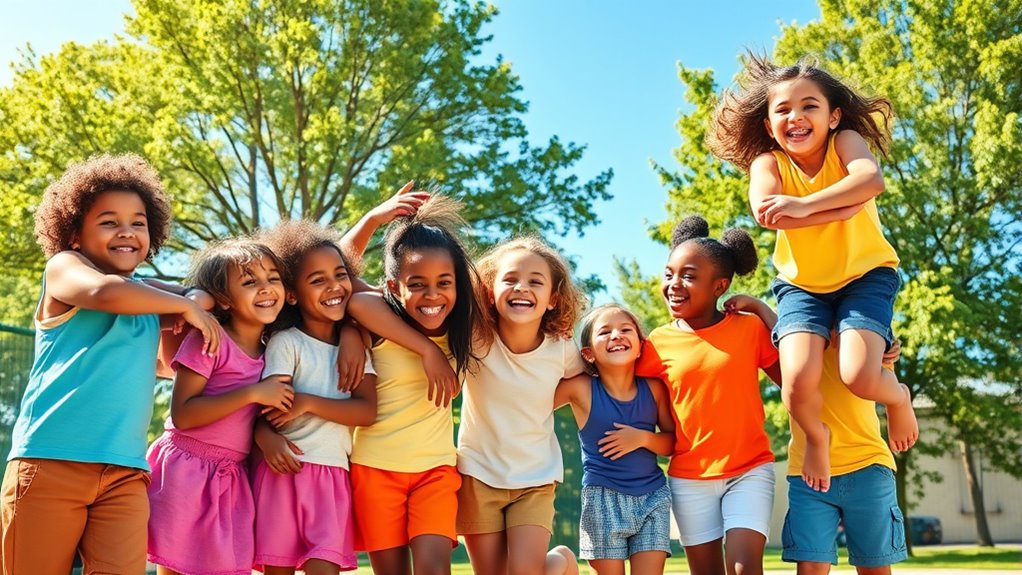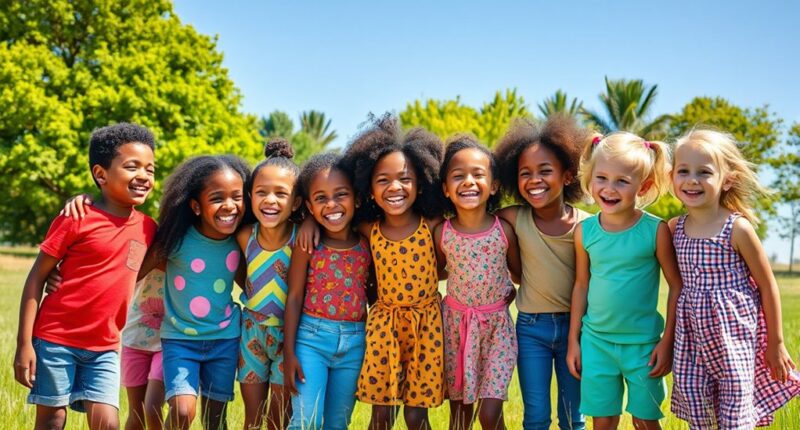To help children love the skin they’re in, focus on building their self-esteem by praising efforts and kindness, not appearance. Teach them to appreciate what their bodies can do and celebrate diversity through inclusive books and toys. Limit media exposure to edited images and explain that true beauty comes in all shapes and colors. By creating a supportive environment and modeling positive attitudes, you can foster lasting confidence—keep exploring for more helpful tips.
Key Takeaways
- Emphasize children’s strengths, talents, and efforts rather than appearance to build confidence and self-esteem.
- Use diverse media and stories that showcase different body types, skin colors, and abilities to promote acceptance.
- Teach kids to recognize and appreciate what their bodies can do, fostering gratitude and positive body image.
- Limit exposure to edited and curated images, explaining that real beauty is diverse and not defined by media standards.
- Model positive self-talk and acceptance of all body types to encourage children to love and appreciate their own skin.

Have you ever wondered how to help kids develop a healthy, confident view of their bodies? It’s a question many parents and caregivers ask, especially in today’s world where media influence shapes so much of what children see and believe about themselves. Teaching kids about body positivity starts with self-esteem building. When children feel good about who they are, they’re less likely to compare themselves to unrealistic images they encounter online or on TV. You can help foster this by focusing on their strengths, talents, and unique qualities rather than just appearance. Praise their efforts, kindness, and perseverance, emphasizing that their worth isn’t tied to looks. By doing this, you’re helping them develop a resilient self-image that isn’t easily shaken by external standards.
Foster self-esteem by focusing on strengths, efforts, and kindness, helping kids build a resilient, positive body image.
Media influence plays a significant role in how children view their bodies. From a young age, they’re exposed to images that often portray narrow beauty ideals, which can lead to feelings of inadequacy or dissatisfaction. As a parent or caregiver, it’s essential to discuss these images openly. Explain that many photos are edited or curated to look perfect, and that real beauty comes in all shapes, sizes, and colors. Encourage your child to question what they see and to recognize that media doesn’t define their value. Limiting exposure to unrealistic images and promoting media literacy helps children develop a more critical eye and a healthier perspective on beauty standards.
Creating an environment that celebrates diversity is another powerful way to promote body positivity. Surround your child with books, shows, and toys that showcase different body types, skin colors, and abilities. Talk about how everyone is unique and that differences should be celebrated, not judged. Reinforce that their body is their own and that it deserves respect and care. Avoid making negative comments about your own body or others’ bodies, as children often internalize these messages. Instead, model positive self-talk and demonstrate acceptance of all body types. When children see adults embracing their bodies, they’re more likely to develop that same confidence.
Finally, encourage your child to focus on what their body can do rather than just how it looks. Celebrate their physical abilities, whether it’s running, dancing, or simply playing. This shift in focus helps them appreciate their body’s functionality and fosters gratitude, which further supports self-esteem building. Additionally, understanding that color accuracy and the ability for a projector to display true-to-life colors can influence how they perceive images and appearances is beneficial. By creating a supportive environment and addressing media influence directly, you’re helping your child develop a healthy, confident attitude about their body—one that’s rooted in self-love and acceptance.
Frequently Asked Questions
How Early Should Parents Start Discussing Body Positivity With Children?
You should start age-appropriate conversations about body positivity early, around age 3 or 4, to foster healthy self-esteem. Early intervention helps children develop a positive body image before societal pressures influence them. Keep language simple and positive, emphasizing uniqueness and self-love. By initiating these talks early, you create a foundation for your child’s confidence, encouraging them to embrace their individuality and build resilience against negativity.
What Are Common Signs of Low Self-Esteem Related to Body Image in Kids?
You notice your child avoiding mirrors, criticizing their appearance, or withdrawing from social activities. These signs often point to low self-esteem related to body image. You can support them by practicing bullying prevention and self-confidence building strategies, encouraging positive self-talk, and celebrating their unique qualities. Pay attention to their feelings, listen actively, and remind them that their worth isn’t determined by looks. Your support helps foster a healthy body image and resilience.
How Can Teachers Promote Body Positivity in the Classroom Effectively?
You can promote body positivity in your classroom by fostering media literacy and using inclusive language. Encourage students to critically analyze media images and messages, highlighting unrealistic standards. Use inclusive language that celebrates diverse body types, backgrounds, and abilities. Create a supportive environment where every child feels valued and respected. By modeling these practices, you help students develop healthier self-esteem and a positive attitude toward their bodies.
Are There Specific Books or Media That Support Body Positivity for Children?
Have you ever wondered which media can truly inspire children to love themselves? You should explore children’s books and media representation that focus on body positivity. Many books feature diverse characters and promote acceptance, while positive media campaigns highlight real stories. These resources help kids see beauty in all forms, encouraging confidence and self-love. Using these tools in your classroom can foster an inclusive environment where every child feels valued and appreciated.
How Can Caregivers Address Body Shaming Among Peers?
You can address body shaming among peers by fostering open conversations and teaching empathy. Encourage your child to stand up against cyberbullying prevention and support their friends through peer support programs. Reinforce the importance of kindness and respect, helping them recognize hurtful comments and respond confidently. By modeling positive behavior and creating a safe environment, you empower your child to challenge body shaming and promote inclusivity among peers.
Conclusion
So, here’s the irony: by teaching kids to love their bodies, you might just be helping them stand out in a world obsessed with perfection. Instead of shaping them into society’s ideal, you’re giving them the confidence to embrace their unique selves. It’s almost like the real ‘body positivity’ secret is simply letting kids be kids—happy, proud, and unapologetically themselves. Who knew that acceptance could be the most powerful thing you teach?









